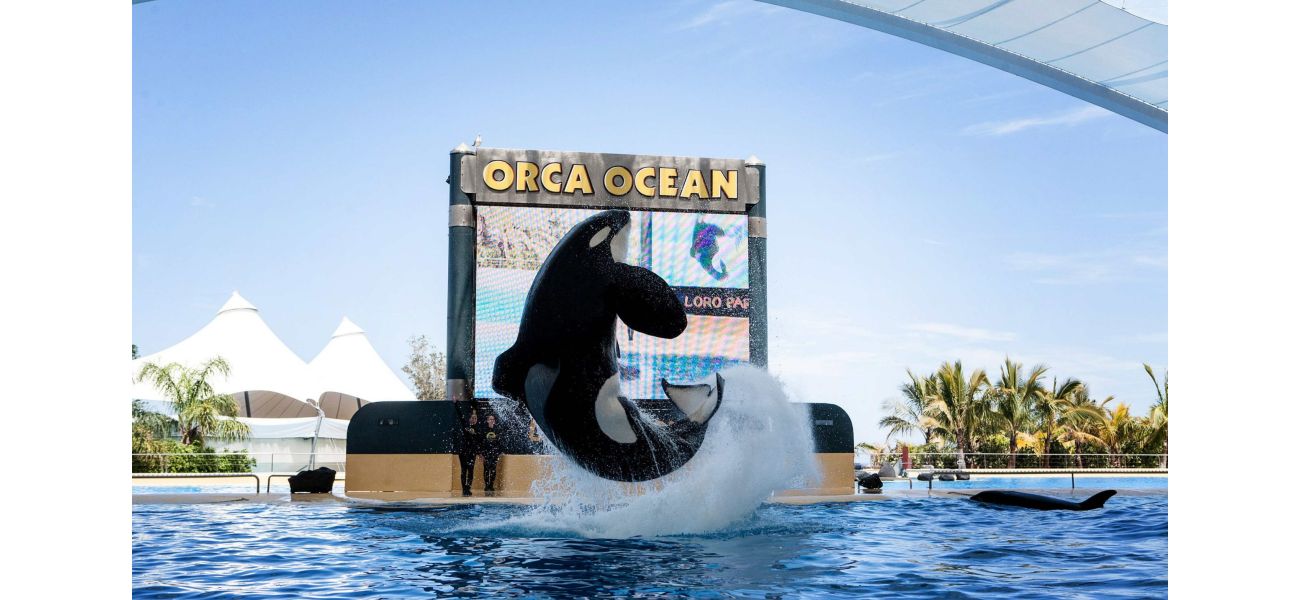Keto, a killer whale, tragically spent its life in a tank and became frustrated.
A group stated that the man's life was filled with frustration, violence, and boredom.
November 27th 2024.

Keto, a 29-year-old killer whale, had spent nearly two decades living in captivity at a Spanish marine park. During this time, he had been a popular attraction, entertaining generations with his impressive jumps and splashes in the chlorinated pool at Loro Parque in Tenerife. However, on Friday, the park announced that Keto had passed away after showing signs of discomfort for several days. An autopsy was conducted by a team of 21 vets over the weekend, but the cause of death has not yet been determined.
The park fondly remembered Keto as an extraordinary ambassador for his species, capturing the hearts of everyone with his commanding presence and unique personality. For the Loro Parque family, Keto was not just an ambassador, but an irreplaceable being who left an indelible mark on their hearts. His memory will continue to live on in those who were fortunate enough to know him, and in all those who learned to admire orcas through him.
However, to animal rights activists, Keto was not an ambassador but a victim. The Whale Sanctuary Project described his life as one of frustration, violence, and boredom. Killer whales have been kept in captivity since 1961, with Keto being one of around 54 held in marine parks worldwide. His father, Kotar, was captured in Iceland in 1978 but tragically died before Keto was born. Keto was born at SeaWorld Orlando in 1995, but at the age of four, he was separated from his mother, Kalina, as part of the park's controversial breeding program.
Keto was then moved to various SeaWorld attractions before finally being transferred to Loro Parque in 2006, where he was used for breeding. According to PETA, he was bred with his own niece, Kohana, and only one of his three calves, Adán, is still alive. Although the zookeepers at Loro Parque claim to have provided Keto with the highest quality of care, his life in captivity took a deep toll on him. He never had the opportunity to see the ocean or experience anything natural for an orca. He was confined to a small pool, unable to swim freely or even see real ocean waves.
The distress of living outside his natural habitat caused Keto to become aggressive. In 2009, he fatally injured his trainer, Alexis Martinez, by dragging him underwater and causing severe injuries. The incident only lasted 40 seconds, and according to SeaWorld, the attack must have been swift and devastating. Sadly, Keto is not the first killer whale to die at Loro Parque, following Ula, Kohana, and Skyla.
Despite the claims of animal rights activists, Loro Parque has always maintained that they provide the highest standards of care for all their animals. However, it is clear that living in captivity had a significant impact on Keto, who was known to chew on the Metflex lining of his tank out of boredom. The stress and frustration of his confinement eventually led to violent behavior, resulting in the tragic loss of a trainer's life.
The dolphinarium expressed their love and gratitude for Keto, remembering him as an exceptional creature and wishing him to rest in peace. Orcas, the largest members of the dolphin family, are typically found in oceans all over the world and feed on chinook salmon. They are known to stay with their birth families for their entire lives, with males living up to 30 years and females up to 90. In captivity, killer whales tend to have a shorter lifespan, with Keto passing away at the age of 29.
The park fondly remembered Keto as an extraordinary ambassador for his species, capturing the hearts of everyone with his commanding presence and unique personality. For the Loro Parque family, Keto was not just an ambassador, but an irreplaceable being who left an indelible mark on their hearts. His memory will continue to live on in those who were fortunate enough to know him, and in all those who learned to admire orcas through him.
However, to animal rights activists, Keto was not an ambassador but a victim. The Whale Sanctuary Project described his life as one of frustration, violence, and boredom. Killer whales have been kept in captivity since 1961, with Keto being one of around 54 held in marine parks worldwide. His father, Kotar, was captured in Iceland in 1978 but tragically died before Keto was born. Keto was born at SeaWorld Orlando in 1995, but at the age of four, he was separated from his mother, Kalina, as part of the park's controversial breeding program.
Keto was then moved to various SeaWorld attractions before finally being transferred to Loro Parque in 2006, where he was used for breeding. According to PETA, he was bred with his own niece, Kohana, and only one of his three calves, Adán, is still alive. Although the zookeepers at Loro Parque claim to have provided Keto with the highest quality of care, his life in captivity took a deep toll on him. He never had the opportunity to see the ocean or experience anything natural for an orca. He was confined to a small pool, unable to swim freely or even see real ocean waves.
The distress of living outside his natural habitat caused Keto to become aggressive. In 2009, he fatally injured his trainer, Alexis Martinez, by dragging him underwater and causing severe injuries. The incident only lasted 40 seconds, and according to SeaWorld, the attack must have been swift and devastating. Sadly, Keto is not the first killer whale to die at Loro Parque, following Ula, Kohana, and Skyla.
Despite the claims of animal rights activists, Loro Parque has always maintained that they provide the highest standards of care for all their animals. However, it is clear that living in captivity had a significant impact on Keto, who was known to chew on the Metflex lining of his tank out of boredom. The stress and frustration of his confinement eventually led to violent behavior, resulting in the tragic loss of a trainer's life.
The dolphinarium expressed their love and gratitude for Keto, remembering him as an exceptional creature and wishing him to rest in peace. Orcas, the largest members of the dolphin family, are typically found in oceans all over the world and feed on chinook salmon. They are known to stay with their birth families for their entire lives, with males living up to 30 years and females up to 90. In captivity, killer whales tend to have a shorter lifespan, with Keto passing away at the age of 29.
[This article has been trending online recently and has been generated with AI. Your feed is customized.]
[Generative AI is experimental.]
0
0
Submit Comment





